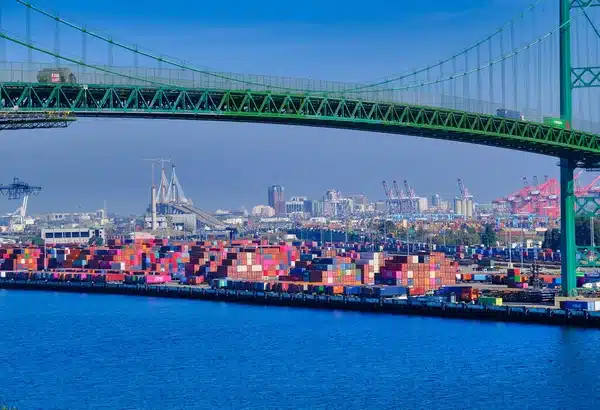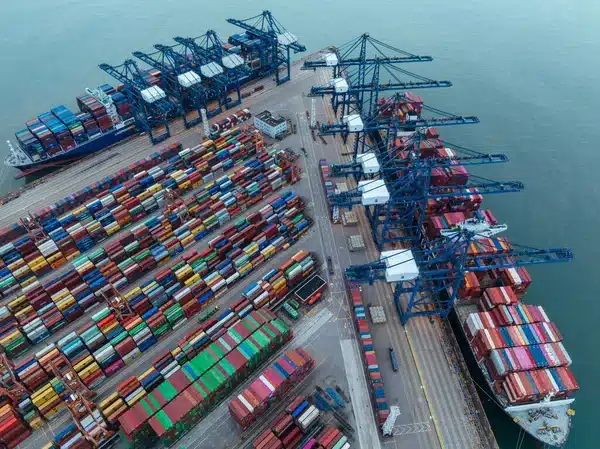The logistics network between China and the USA is one of the most vital and complex global trade routes, underpinning economic ties between the world’s two largest economies. It involves the seamless movement of goods via sea, air, and multimodal transport, supported by an extensive infrastructure of ports, carriers, and customs systems.
This robust logistics framework enables the efficient delivery of a wide variety of goods, from consumer electronics and machinery to apparel and perishable items, ensuring businesses remain competitive in an increasingly globalized market.

Table of Contents
Importance of Logistics Between China and the USA
1. Economic Significance
- China as a Global Export Leader: China is the USA’s largest trading partner, supplying a significant portion of consumer goods, electronics, and industrial equipment.
- The USA as a Key Consumer Market: U.S. demand for Chinese products drives the need for efficient logistics solutions, supporting industries across both nations.
2. Supply Chain Integration
- The logistics link between China and the USA facilitates just-in-time inventory management, critical for industries like manufacturing, retail, and e-commerce.
- Reliable logistics ensure minimal disruptions to global supply chains, even during peak seasons or geopolitical tensions.
3. Trade Relationship Resilience
- Despite challenges like tariffs and trade wars, the flow of goods between China and the USA remains robust, highlighting the importance of resilient logistics systems.
Trade Volume and Key Industries Relying on China-USA Shipping
1. Trade Volume
- Export Volume from China: In 2023, China exported goods worth over $560 billion to the USA, showcasing the magnitude of trade between the two countries.
- Top Categories of Goods: Electronics, machinery, textiles, furniture, and toys dominate the list of goods shipped from China to the USA.
2. Key Industries
- Consumer Electronics: Smartphones, laptops, and accessories are among the most commonly shipped items.
- Apparel and Textiles: The fashion industry depends heavily on Chinese manufacturers for affordable and high-quality products.
- E-Commerce: U.S.-based platforms like Amazon and Shopify rely on streamlined logistics from China to meet consumer demand.
- Machinery and Industrial Equipment: Critical for manufacturing and construction industries in the USA.
- Medical Supplies: Includes personal protective equipment (PPE), medical devices, and pharmaceuticals.

The Role of Major Ports in Facilitating Global Trade
1. Major Chinese Ports as Export Hubs
- Shanghai Port: The world’s largest port by cargo throughput, a gateway for consumer goods and electronics to the USA.
- Shenzhen Port: A hub for high-tech exports, connecting directly to U.S. West Coast ports like Los Angeles.
- Ningbo-Zhoushan Port: Handles bulk cargo and containerized shipments to U.S. East Coast destinations.
- Guangzhou and Tianjin Ports: Serve as critical nodes for South and North China, ensuring comprehensive coverage for various industries.
2. Major U.S. Ports as Import Gateways
- Port of Los Angeles and Long Beach: Combined, these ports handle over 40% of U.S. imports from China, making them essential for trade efficiency.
- Port of New York and New Jersey: Facilitates access to the populous Northeast region.
- Port of Savannah and Houston: Provide connectivity to the Southeast and Gulf regions, supporting distribution across inland markets.
3. Enhancing Global Trade Efficiency
- Advanced Port Infrastructure: Automation, smart technology, and efficient cargo handling systems reduce delays and improve shipment accuracy.
- Strategic Geographical Locations: Ports in China and the USA are strategically positioned to serve as critical nodes in the global supply chain.
- Collaborative Ecosystem: Partnerships between shipping lines, freight forwarders, and customs authorities ensure smooth operations, even for complex shipments.
Major Ports in China
China’s port network is a cornerstone of global trade, enabling the country to maintain its position as the world’s largest exporter. With advanced infrastructure, strategic locations, and a high volume of throughput, these ports are integral to international logistics, especially for shipments to major markets like the USA.
1. Overview of China’s Port Network
China’s Leadership in Global Port Infrastructure
- Global Dominance: China is home to 7 of the 10 busiest ports in the world, with state-of-the-art facilities that handle vast quantities of goods efficiently.
- Advanced Technology: Investments in automation, artificial intelligence, and green port initiatives have made Chinese ports some of the most efficient globally.
- Volume of Trade: China’s ports handle billions of tons of cargo annually, supporting industries ranging from electronics to heavy machinery.
Strategic Locations for Key Manufacturing and Export Hubs
- Yangtze River Delta: Ports like Shanghai and Ningbo-Zhoushan serve as gateways for goods produced in Eastern China’s manufacturing hubs.
- Pearl River Delta: Shenzhen and Guangzhou ports facilitate exports from Southern China, including electronics and textiles.
- Northern China: Tianjin and Qingdao connect northern industries to international markets, focusing on machinery, chemicals, and agricultural products.
2. Key Ports in China
Shanghai Port
- Overview: The largest and busiest port in the world by cargo throughput.
- Specialization: Handles a wide range of goods, including electronics, textiles, and machinery.
- Global Connectivity: Serves as a critical hub for trade with the USA, particularly West Coast ports like Los Angeles and Long Beach.
Shenzhen Port
- Overview: Comprises multiple sub-ports, including Yantian, Shekou, and Chiwan.
- Specialization: High-tech exports such as smartphones, laptops, and telecommunications equipment.
- Strategic Role: Directly connected to U.S. West Coast ports, making it a vital link for e-commerce and technology sectors.
Ningbo-Zhoushan Port
- Overview: A rapidly growing port, ranking among the busiest globally.
- Specialization: Ideal for bulk cargo and containerized shipments, including machinery and consumer goods.
- Connectivity: Key for shipments heading to U.S. East Coast ports via the Panama Canal.
Guangzhou Port
- Overview: A critical hub for Southern China’s industrial exports.
- Specialization: Handles industrial equipment, furniture, and heavy machinery.
- Importance for USA Trade: Facilitates trade to the Gulf Coast and southeastern USA.
Tianjin Port
- Overview: Northern China’s largest port, connecting the region to global markets.
- Specialization: Machinery, chemicals, and agricultural products.
- Role in Trade: Essential for industries in Beijing and surrounding provinces exporting to the USA.
Qingdao Port
- Overview: A leading port in handling refrigerated goods and agricultural exports.
- Specialization: Seafood, fresh produce, and processed foods.
- Unique Feature: Advanced facilities for temperature-sensitive shipments, catering to niche markets in the USA.
3. Specializations of Chinese Ports
Containerized Cargo Handling
- Advanced container terminals with high automation and quick turnaround times.
- Significant for shipping consumer goods, electronics, and e-commerce products.
Bulk Goods and Heavy Equipment
- Ports like Ningbo-Zhoushan and Tianjin handle large volumes of bulk commodities, such as steel, coal, and machinery.
- Specialized cranes and storage facilities support efficient handling of oversized goods.
Refrigerated and Specialized Goods
- Ports such as Qingdao and Shanghai have state-of-the-art cold storage facilities.
- Ideal for shipping perishables like seafood, fresh produce, and pharmaceuticals.

Major Ports in the USA
The United States port system plays a crucial role in facilitating international trade, serving as entry points for goods shipped from China and other global markets. These ports are strategically located along the West Coast, East Coast, and Gulf Coast, enabling efficient distribution of imports across the nation.
1. Overview of the U.S. Port System
Importance of U.S. Ports in Facilitating Imports from China
- High Trade Volume: U.S. ports handle millions of containers annually, with a significant portion originating from China, reflecting the robust trade relationship between the two countries.
- Economic Contribution: Ports are vital to the U.S. economy, supporting industries such as retail, manufacturing, and technology by ensuring a steady flow of imported goods.
- Global Connectivity: These ports act as gateways for international trade, ensuring seamless transportation of goods via sea and multimodal networks.
Coastal Distribution of Major Ports
- West Coast Ports: Primarily handle shipments from China due to shorter transit times across the Pacific Ocean.
- East Coast Ports: Serve as key entry points for goods routed through the Panama Canal or transshipped via other ports.
- Gulf Coast Ports: Provide access to inland U.S. markets and Latin America, handling a mix of industrial, chemical, and consumer goods.
2. Key Ports
1.Port of Los Angeles
- Overview: The busiest port in the United States and a critical hub for trade with China.
- Specialization: Handles consumer goods, electronics, and apparel.
- Importance: Acts as the primary entry point for goods shipped from major Chinese ports like Shanghai and Shenzhen.
2.Port of Long Beach
- Overview: Adjacent to the Port of Los Angeles, forming the San Pedro Bay Port Complex.
- Specialization: High-volume containerized goods, including furniture and household items.
- Importance: A key partner for Chinese exports, leveraging advanced infrastructure to handle large cargo volumes efficiently.
3.Port of New York and New Jersey
- Overview: The largest port on the East Coast, serving as a gateway to the populous Northeast and Midwest regions.
- Specialization: Machinery, industrial goods, and consumer products.
- Importance: Ideal for shipments routed through the Panama Canal, connecting to major cities like New York, Boston, and Chicago.
4.Port of Savannah
- Overview: One of the fastest-growing ports in the U.S., located in Georgia.
- Specialization: Containerized goods, agricultural products, and retail imports.
- Importance: Serves as a key distribution hub for the Southeastern U.S., with proximity to major cities like Atlanta and Orlando.
5.Port of Houston
- Overview: The largest port on the Gulf Coast, critical for handling industrial goods.
- Specialization: Chemicals, petroleum products, and heavy machinery.
- Importance: Provides access to inland markets in the southern and central U.S. while also serving trade routes to Latin America.
3. Regional Importance of U.S. Ports
West Coast Ports: Shorter Transit Times for Pacific Routes
- Key Ports: Los Angeles, Long Beach, and Oakland.
- Transit Efficiency: Goods from China reach these ports in 15-20 days, making them ideal for time-sensitive shipments.
- Industry Impact: Supports industries such as retail, technology, and e-commerce by ensuring rapid delivery.
East Coast Ports: Serving the Midwest and Northeast
- Key Ports: New York/New Jersey, Savannah, and Charleston.
- Distribution Reach: Serves major population centers and industrial regions, often accessed via the Panama Canal.
- Industry Impact: Handles a diverse range of goods, from machinery to consumer products, ensuring supply chain efficiency for the eastern U.S.
Gulf Coast Ports: Access to Latin America and Southern U.S. Markets
- Key Ports: Houston, New Orleans, and Mobile.
- Strategic Role: These ports specialize in industrial and chemical imports, catering to the energy and manufacturing sectors.
- Industry Impact: Offers direct shipping routes to Central and South America, enhancing trade opportunities.
Popular Shipping Routes from China to the USA
1. Direct Pacific Routes
- Most efficient route for shipments from Chinese ports to U.S. West Coast ports.
- Transit Time: 15-20 days.
2. Panama Canal Routes
- Connects Chinese ports to U.S. East and Gulf Coasts via the Panama Canal.
- Transit Time: 25-30 days.
3. Transpacific Eastbound (TPEB)
- Primary trade lane for China-USA shipments, serving major ports like Los Angeles and New York.
4. Multimodal Shipping
- Combining sea freight with rail and road transportation for inland destinations in the USA.
You may also be interested in:
Sea Freight Door-to-Door Shipping: Shenzhen, China to the USA
Logistics Methods from China to the USA
Shipping goods from China to the USA requires selecting the most appropriate logistics method based on factors like cargo size, urgency, and budget. Businesses can choose from ocean freight, air freight, express shipping, or multimodal transport, each offering unique advantages.
1. Ocean Freight
Ocean freight is the most economical method for shipping large quantities of goods. It is ideal for businesses that prioritize cost savings over speed.
FCL (Full Container Load)
- Description: The entire container is booked for a single shipment.
- Best For: Large shipments or goods requiring privacy and security.
- Benefits:
- Cost-effective for bulk cargo.
- Reduces risk of damage as the container is not shared.
LCL (Less-than-Container Load)
- Description: Multiple shipments from different shippers are consolidated into one container.
- Best For: Smaller shipments that don’t fill an entire container.
- Benefits:
- More affordable for low-volume cargo.
- Flexible for small and medium-sized businesses.
Specialized Containers
- Description: Customized containers for unique cargo needs.
- Types:
- Refrigerated Containers (Reefers): For perishable goods like seafood or pharmaceuticals.
- Flat Rack Containers: For oversized goods such as machinery.
- Open Top Containers: For goods that cannot be loaded through standard container doors.
2. Air Freight
Air freight is the fastest logistics option, making it ideal for time-sensitive shipments or high-value items.
- Fastest Transit Time: Deliveries typically take 3-7 days from China to the USA.
- Suitable For:
- Lightweight cargo, such as electronics, fashion items, or luxury goods.
- Urgent shipments requiring quick turnaround.
- Benefits:
- Reduced risk of damage compared to sea freight.
- High reliability for meeting deadlines.
- Limitations:
- Higher cost compared to ocean freight.
- Weight and size restrictions apply.
3. Express Shipping
Express shipping provides a door-to-door solution for small parcels and e-commerce products. It is highly reliable for quick deliveries.
- Leading Providers: DHL, FedEx, UPS, and TNT.
- Best For:
- Small parcels and documents.
- E-commerce businesses shipping directly to customers.
- Transit Time: Typically 2-5 days, depending on the provider and destination.
- Benefits:
- End-to-end service with tracking and customs clearance included.
- Ideal for businesses needing consistent and fast deliveries.
- Limitations:
- High costs per kilogram, especially for heavier packages.
4. Multimodal Transport
Multimodal transport combines different logistics methods (sea, air, rail, and road) to optimize costs and transit times.
- Description: Goods are shipped using a combination of modes under a single contract.
- Best For:
- Shipments requiring both cost efficiency and moderate speed.
- Deliveries to inland U.S. destinations far from major ports.
- Examples of Multimodal Options:
- Sea + Rail: Goods shipped by ocean to Canada or Mexico, then transported by rail to the USA.
- Sea + Air: Combining sea freight for cost savings with air freight for faster final delivery.
- Benefits:
- Flexibility in routes and modes.
- Lower overall costs compared to air-only shipments.
- Limitations:
- Complex coordination between multiple carriers.
Choosing the Right Logistics Method
| Method | Best For | Key Considerations |
|---|---|---|
| Ocean Freight | Large or bulky shipments | Low cost but slower transit times. |
| Air Freight | Urgent or high-value goods | Fast delivery with higher costs. |
| Express Shipping | Small parcels or e-commerce goods | Fast and reliable but expensive. |
| Multimodal Transport | Cost-effective inland deliveries | Requires careful planning. |
Shipping Costs and Transit Times from China to the USA
Shipping costs and transit times from China to the USA are influenced by several factors, including the mode of transport, cargo type, and market conditions. Understanding these variables can help businesses choose the most suitable logistics solution.
Factors Affecting Costs
1. Cargo Type and Volume
- Type of Goods: Fragile, high-value, or hazardous goods often incur higher shipping rates due to additional handling or compliance requirements.
- Shipment Volume: Large shipments (e.g., FCL) are more cost-effective per unit compared to smaller shipments (e.g., LCL or express parcels).
2. Mode of Transport (Ocean, Air, or Express)
- Ocean Freight: Economical for bulk goods but slower.
- Air Freight: Faster but more expensive, ideal for urgent or high-value items.
- Express Shipping: Premium pricing for small parcels with door-to-door service.
3. Seasonal Demand and Peak Periods
- Peak Seasons: Shipping costs rise during periods like Chinese New Year, Black Friday, and the holiday season due to increased demand.
- Market Fluctuations: Changes in fuel prices, port congestion, or geopolitical issues can affect freight rates.
Cost and Time Estimates
The following table provides an overview of estimated shipping costs and transit times for different modes of transport between China and the USA:
Here is the updated shipping cost table for March 2025:
| Route | Mode | Transit Time | Cost Range (USD) |
|---|---|---|---|
| Shanghai to Los Angeles | Ocean Freight | 15-20 days | $1,400-$1,850 (FCL) |
| Shenzhen to Long Beach | Ocean Freight | 18-22 days | $80-$150 per CBM (LCL) |
| Ningbo to Savannah | Ocean Freight | 25-30 days | $2,260-$2,800 (FCL) |
| Shanghai to New York | Air Freight | 3-7 days | $5-$6 per kg |
| Guangzhou to Houston | Air Freight | 5-8 days | $5.5-$7 per kg |
| Beijing to Chicago | Express Shipping | 2-5 days | $20-$30 per kg |
Cost Considerations:
- Ocean Freight Costs:
- FCL rates vary based on container size (20ft vs. 40ft) and specific routes.
- LCL pricing is calculated per cubic meter (CBM).
- Air Freight Costs:
- Pricing depends on cargo weight and volumetric weight (dimensional weight).
- Express Shipping Costs:
- Higher rates for lightweight, high-value shipments, including customs clearance.

Logistics Clearance from China to the USA
Customs clearance is a critical step in the logistics process when shipping goods from China to the USA. Proper documentation and compliance with import/export regulations ensure a smooth and hassle-free shipment.
1. Customs Clearance in China
Exporting goods from China involves preparing and submitting the required documents to Chinese customs authorities. Failure to comply with these requirements can lead to delays or penalties.
Documentation Requirements
Commercial Invoice:
- Provides detailed information about the goods, including their description, quantity, unit price, and total value.
- Used for customs valuation and duty assessment.
Packing List:
- Details the packaging of the goods, including weight, dimensions, and contents of each package.
- Helps customs officials verify the shipment’s contents.
Export Declaration:
- A mandatory document filed with Chinese customs for approval before goods can leave the country.
- Includes details about the exporter, shipment, and value of goods.
Key Considerations for Export Clearance
- Ensure all documents are accurate and consistent to avoid delays.
- Work with your freight forwarder to navigate specific requirements for restricted or regulated goods, such as electronics or hazardous materials.
2. Customs Clearance in the USA
Once goods arrive in the USA, they must go through import customs clearance before delivery to the final destination. This process involves submitting the required documents to U.S. Customs and Border Protection (CBP).
Import Documentation
- A document issued by the carrier, serving as proof of shipment and outlining the terms of transport.
- Required for releasing goods at the destination port.
Certificate of Origin (CO):
- Certifies the country where the goods were manufactured.
- Required for duty calculation and compliance with trade agreements.
HTS Code Classification:
- Goods must be classified under the Harmonized Tariff Schedule (HTS) to determine applicable duties and taxes.
- Proper classification is crucial to avoid overpaying tariffs or facing penalties for incorrect categorization.
Common Challenges
Tariffs and Duties:
- The USA imposes varying tariffs based on the type of goods and their HTS classification.
- Additional tariffs (e.g., Section 301 duties on Chinese goods) may apply, increasing costs.
Import Restrictions on Specific Goods:
- Some products, such as electronics with lithium batteries or food items, require additional permits or certifications.
- Non-compliance with U.S. regulations, such as FDA or EPA standards, can result in shipment rejection.
Important Considerations for Businesses
Shipping goods from China to the USA involves multiple decision-making factors to ensure cost efficiency, timely delivery, and regulatory compliance. Below are critical considerations for businesses to optimize their logistics strategies.
1. Choosing the Right Ports and Routes
Selecting the most appropriate ports and shipping routes is crucial to minimize transit times and costs.
Match Ports to Proximity of Manufacturing and Distribution Hubs
- In China:
- Choose ports near manufacturing centers to reduce inland transportation costs.
- For example:
- Shanghai Port for goods from the Yangtze River Delta.
- Shenzhen Port for products from Guangdong and southern China.
- In the USA:
- Select U.S. ports close to distribution centers or final destinations.
- For example:
- Port of Los Angeles for West Coast deliveries.
- Port of Savannah for Southeastern USA distribution.
Evaluate Routes Based on Transit Time
- Direct Pacific Ocean routes are ideal for shipments to West Coast ports, offering shorter transit times (15-20 days).
- Panama Canal routes provide access to East Coast ports but require longer transit times (25-30 days).
2. Managing Costs
1. Consolidate Smaller Shipments
- Use LCL (Less-than-Container Load) options to combine multiple shipments into one container.
- This approach is more cost-effective for small to medium-sized shipments, as costs are shared among multiple shippers.
2. Compare Shipping Quotes
- Obtain quotes for various modes of transport, including ocean freight, air freight, and express shipping.
- Consider trade-offs between cost and speed:
- Ocean Freight: Cheapest but slowest.
- Air Freight: Faster but more expensive.
- Express Shipping: Premium service for small parcels.
3. Plan Shipments During Off-Peak Seasons
- Avoid peak shipping seasons like Chinese New Year and the holiday season, when freight rates typically increase.
- Book shipments early to secure space and lock in lower rates.
3. Ensuring Compliance
1. Stay Updated on U.S. Import Regulations
- Customs Requirements:
- Ensure proper classification of goods using the Harmonized Tariff Schedule (HTS).
- Be aware of additional tariffs or trade restrictions, especially on goods originating from China.
2. Understand Product-Specific Standards
- Certain goods, such as electronics, toys, or food items, may require certifications or meet safety standards regulated by:
- FDA (Food and Drug Administration)
- CPSC (Consumer Product Safety Commission)
- EPA (Environmental Protection Agency)
3. Budget for Tariffs and Duties
- Calculate applicable duties based on the HTS codes and origin of the goods.
- Plan for additional tariffs like Section 301 duties on certain Chinese imports, which may increase overall costs.
Tonlexing Logistics: Your Partner in International Shipping
Why Choose Tonlexing?
- Expertise in Major Ports: Seamless handling of shipments across key China and U.S. ports.
- Comprehensive Services: From cargo pickup to last-mile delivery.
- Transparent Pricing: Competitive rates for all shipping methods.
Tonlexing Logistics Workflow
- Cargo Pickup: From factories or suppliers in China.
- Export Clearance: Efficient handling of Chinese customs.
- Main Transportation: Ocean, air, or express freight.
- Import Clearance: Smooth processing through U.S. customs.
- Final Delivery: Direct to the recipient’s location.


